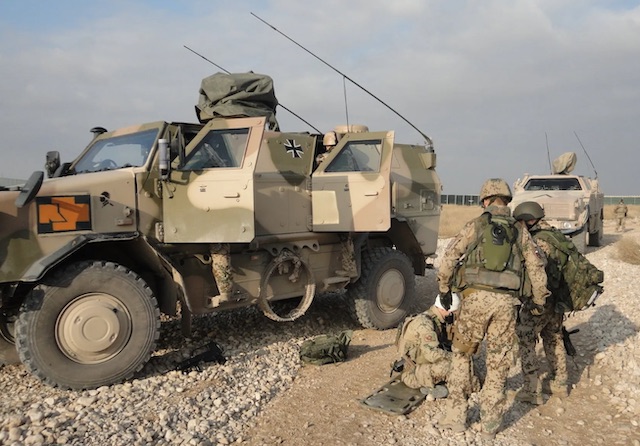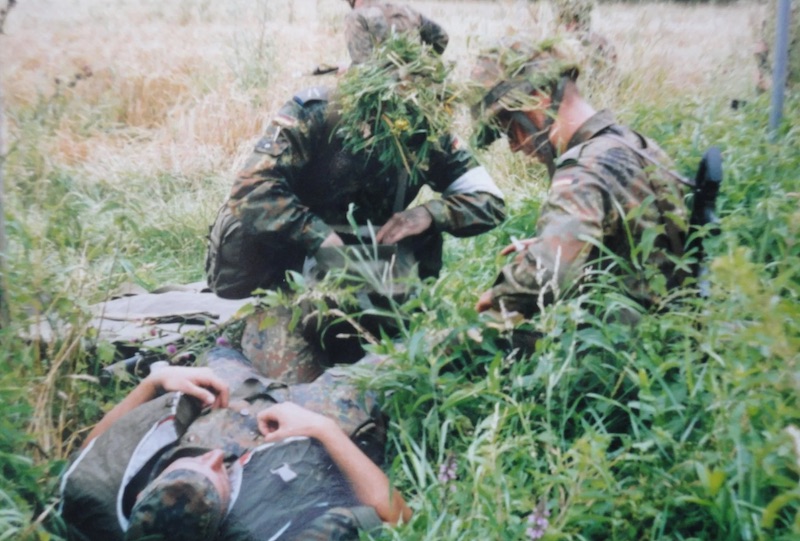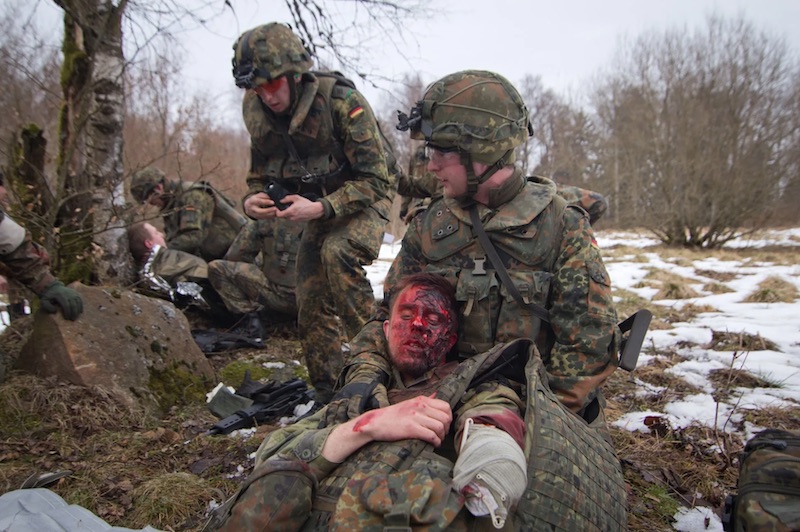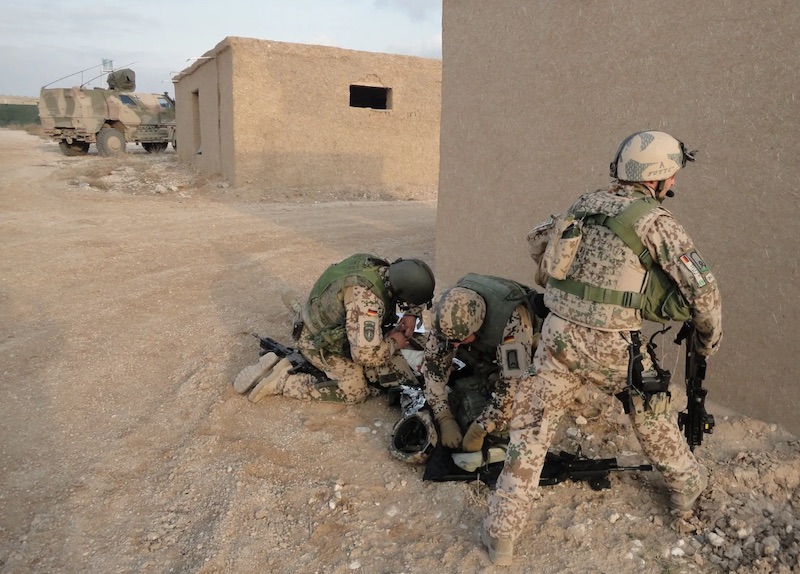Hol Dir den wöchentlichen SPARTANAT-Newsletter.
Dein Bonus: das gratis E-Book von SPARTANAT.

Wer ist ein „Combat Medic“
Die etwas schwierige Handhabung dieses Begriffs, "Combat Medic", wird in diesem Text analysiert. Der Begriff stammt aus dem amerikanischen Englisch und wurde von den Amerikanern zuerst verwendet.
Der etwas schwierige Umgang mit diesem Begriff
Der Umgang mit dem Begriff „Combat Medic“ ist etwas schwierig. Immer wieder taucht die Bezeichnung auf. Carsten von der Capsarius Akademie hat sich nun die Mühe gemacht, diesen Begriff etwas genauer zu betrachten, um letztendlich auch festzustellen, wer sich selbst als „Combat Medic“ bezeichnen darf.
Allein die Wortwahl lässt schnell erkennen, dass dieser Begriff des Combat Medic aus dem US amerikanischen Sprachgebrauch kommt. Also galt mein erster Blick in die Ausbildungslandschaft der amerikanischen Streitkräfte.
Die Amerikaner haben angefangen
Dort unterteilte man schon seit vielen Jahren die Soldaten des Sanitätsdienstes (Medical Personell) und die der Kampftruppe mit erweiterten Befähigungen der Ersten Hilfe, über die der Selbst- und Kameradenhilfe hinaus (buddy aid). Zuerst nur im Spektrum der Spezialkräfte, z.B. Special Forces zu finden (trauma specialist/special operations forces combat medics), wurde diese Zusatzqualifikation, bekannt als Combat Life Safer (CLS) auch anderen Kampftruppenverbänden angeboten. Der CLS ist inzwischen fester Bestandteil bei der medizinischen Zusatzqualifikation in den US Streitkräften, und das bei allen Teilstreitkräfte.
Hier tauchte also zum ersten Mal der Begriff des COMBAT MEDICS auf. Ein Nichtsanitäter mit medizinischen Kenntnissen über die Selbst- und Kameradenhilfe hinaus.

Die Bundeswehr hatte seit ihrem Bestehen auch eine Trennung zwischen Sanitätsdienst und dem Truppensanitätsdienst. Das bedeutete, dass gerade in den Kampftruppenverbänden des Heeres ein eigener Sanitätsdienst auf Bataillonsebene bestand. Sanitätsdienstgrade,waren in einem Colourverhältnis ihren Kampfkompanien zugeteilt. Man übte zusammen und kannte sich.
Deutsche Sanitäter bei Kampftruppenverbänden
Die Sanitäter bewegten sich auf Ebene der Kompanieführung und waren mit den taktischen Belangen der jeweiligen Einheiten vertraut. Mit Aufstellung des Zentralen Sanitätsdienstes, wurde dieses Zusammenspiel stark verändert, bis hin zum Umstand, dass Sanitäter abgestellt an Kampftruppen keinerlei Vorstellung von deren Verfahrensweisen hatten.
Ausschließlich die Spezialkräfte, allen voran die Luftlandetruppe, behielten sich die alte Verfahrensweise bei. Die Luftlandesanitätskompanien versorgten die Fallschirmjägereinheiten. Man kannte sich.

Mit Einführung der veränderten Ersthelferausbildung für Nicht-Sanitätspersonal, dem Einsatzersthelfer Bravo, wurde ein dem CLS vergleichbares Modell geschaffen. Die Spezialkräfte des Heeres sowie der Marine hatten etwas früher mit dem Combat First Responder (CFR) einen eigenen Weg gefunden, speziell ausgebildetes Personal bei der Kampftruppe vorne dabei zu haben. Auch hier waren die CFR keine Sanitäter.
Einsatzersthelfer Bravo in Afghanistan und Mali
In den Einsätzen, hier besonders in Afghanistan und aktuell Mali, stellen diese Einsatzersthelfer Bravo, bzw. Combat First Responder einen wesentlichen Anteil bei der Versorgung von Verwundeten. Sie ergänzen die Rettungskette in den Einsatzgebieten erheblich und tragen zur verbesserten Versorgung Verwundeter bei.
Hier hat also auch die Bundeswehr ihre COMBAT MEDICS implimentiert. Auch wenn sie sich mit dem Bergiff des Medics immer schwer getan hat und tut. Der offizielle Begriff ist immer noch der des Nicht-Sanitätspersonals, im Truppenalltag sprechen aber viele bereits lange vom Medic. Dies meist mit Lob und Respekt.

In den Einsatzgebieten wird dieser Begriff des Medics dann häufig, gerade im internationalen Sprachgebrauch zum COMBAT MEDIC.
Wir von Capsarius Akademie sind auf alle Fälle mächtig stolz auf die Leistungen der Combat Medics und haben für Euch ein ganz besonderen Patch kreiert.

Zeigt was Ihr seid, tragt diesen Patch mit Würde. HIER im Shop auf der CAPSARIUS Homepage.
Wer den aktuellen Newsletter CALLSIGN DOC exklusiv und automatisch bekommen will ohne einen zu versäumen, muss sich HIER eintragen. CALLSIGN DOC landet dann per Mail. Alte Ausgaben sind im Archiv auf der Homepage der Capsarius Akademie verfügbar.
CAPSARIUS AKADEMIE im Internet: www.capsarius-akademie.com
SPARTANAT ist das Online-Magazin für Military News, Tactical Life, Gear & Reviews.
Schickt uns eure News: [email protected]
Werbung
Hol Dir den wöchentlichen SPARTANAT-Newsletter.
Dein Bonus: das gratis E-Book von SPARTANAT.


